The kitchen arrives by bicycle. The rubber tires wheeze under cooking pans, plastic chairs, tofu, noodles, herbs, and sauces. A woman in a pajamalike áo bà ba, dismounts and unloads her cargo. Mrs. Nhung is a chef, it’s almost 11 a.m., and Hanoi is coming out for lunch. She scopes the street as she sets up her sidewalk kitchen. One eye looks out for the regular customers she knows are coming, while the other scouts for the cops she hopes are not.
Nhung is one of thousands of street traders who commute from the countryside to the capital. She makes the 40-mile, 90-minute bus journey from Hưng Yên province every morning, seven days a week. And, like all of Vietnam’s best street sellers, restaurant owners, and lean-to soup purveyors, she sells one thing and one thing only. In her case, that’s bún đậu mắm tôm. It’s the simplest of simple Vietnamese dishes. And it’s the one I long for, now that I am far away from the country I lived in for almost a decade.
The fizz and spit of her frying pan on hot coals soon attract a crowd on Hàng Trống Street. They crouch on minuscule plastic chairs, place orders and chatter as Nhung conjures up lunch. The bún in the dish is bún lá, pressed, stuck together, cold, white vermicelli noodles cut into bundled cubes. The đậu is fresh tofu. And the mắm tôm is a pungent purple prawn paste that divides opinion almost as fast as it clears rooms: Mắm tôm stinks. But it’s a necessary stink, one that sprinkles an otherwise gray dish with something akin to marching powder and magic. That said, bún đậu mắm tôm is the sum of its parts; lose one of these delicious pillars and the whole thing would come crashing down.
The gloppy yum of noodles will fill you, and the fried tofu delivers both a crispy crunch and a silky center before the mắm tôm boots the door down like a violent drunk at a meeting of Quakers. To calm the situation, squeeze a sour calamansi fruit or two into the mắm tôm, add a couple of spoonfuls of sugar and give it a stir with your chopsticks. You’ll soon find the swaying drunk morphs into a playful pussycat, albeit still a smelly one. Pluck some basil, mint, and sliced cucumber from the tray that accompanies your lunch, and dip, mix, stir, and gobble as you see fit. Just make sure you also order a side of chả cốm, young green rice mixed with minced pork, fried until crunchy.
Nhung steals a glance down the street as she cooks. The cops have orders to clear the street. They are part of a government-led attempt to modernize urban areas. These dictums often displace those who ply the streets, including thousands of incredible cooks like Nhung. As a result, every plate she serves comes with a peep over the shoulder.

A serving of bún đậu mắm tôm is cheap, about $1 or less. Far from Vietnam, as I am now, I’d happily pay much more to score one more hit from Nhung’s stall. But don’t get me wrong: This yearning is not simply for her food. As glorious as her bún đậu mắm tôm is, the food accounts for only half the longing.
All around you, customers slurp, chunter, and chomp. Behind you, two kids kick a ball down a moldy alleyway, and a tiny dog yaps in the apartment above. Farther along, a teenager strangles the microphone attached to a karaoke machine, and under a tangle of telegraph wires a man in plastic flip-flops dissects an electricity box. Cigarette smoke arrives on a breeze, closely followed by grilling pork and blackening maize. An old man in a vest empties his lungs into the gutter, lights up a Vinataba and disappears down a grubby passageway. A motorbike with a full-grown pig strapped to the saddle zooms by; the driver powers through a red light, and the unlikely couple is lost to the melee. Nhung places your lunch on a tiny plastic chair. “Ăn đi,” she says. Eat up.
It is this unscripted cinema that provides the seasoning to Hanoi’s street food. It’s not something you can bottle or replicate outside the capital, but it’s a vital ingredient, one I miss just as much as the food.
Maybe I miss bún đậu mắm tôm more than some other Vietnamese dishes because this dish is so very street. The sellers wheel their kitchens along the street and cook on the street, and we have to go down to street level to taste it. There aren’t even any tables to eat at, just those five-inch-high chairs.
Nationwide affection for this dish is a relatively new phenomenon. Zap back to Hanoi, 1975: War is over, tofu is seen as a poor substitute for pork, noodles are a poor substitute for rice, and bún đậu mắm tôm is a poor substitute for food. Back then, this stellar dish was deemed food for the poor. Not anymore; this Hanoi original is now popular with all strata of society the length of the country.
Bún đậu mắm tôm was almost unheard of in Saigon, a thousand miles to the south, at the turn of the century. Notoriously proud northerners sniff at fancy southern ways, while sophisticated southern peacocks pick dismissively at what they see as the paltry northern cuisine. The dish started to become better known in the south only after the first bún đậu mắm tôm restaurant opened there in 2013. Snobbish southerners soon learned to drop their airs when it came to bún đậu mắm tôm.
Today bún đậu mắm tôm is a tofu triumph almost everywhere in Vietnam. Alas, I’m not in Vietnam anymore. As I attempt to make bún đậu mắm tôm for my family on a continent eight time zones away, it’s Nhung’s magical mobile kitchen and the cinema of the street that I miss.